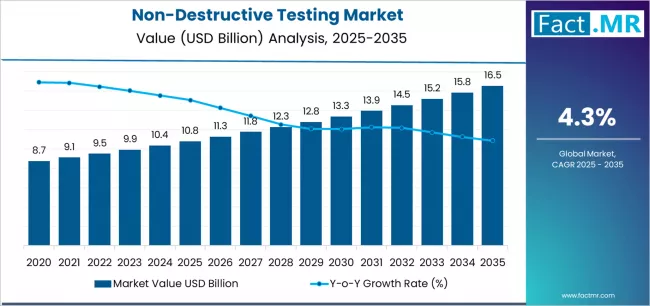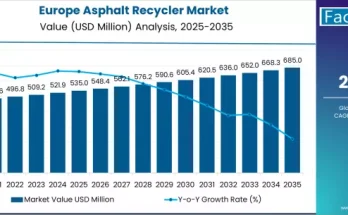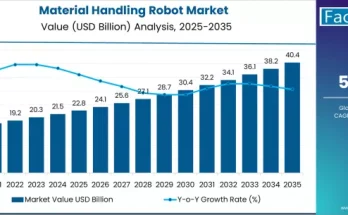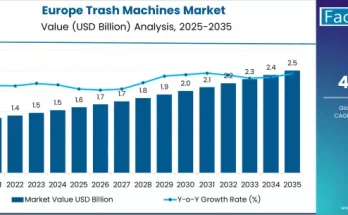The non-destructive testing (NDT) market is witnessing robust growth as industries worldwide prioritize safety, quality, and reliability in manufacturing, infrastructure, and energy sectors. Non-destructive testing encompasses a range of techniques used to evaluate the properties of materials, components, and systems without causing damage or compromising functionality.
As safety standards become increasingly stringent and operational efficiency gains importance, NDT is emerging as a critical component of quality assurance. Industries such as aerospace, automotive, oil and gas, construction, and power generation are relying on NDT methods to detect defects, assess structural integrity, and ensure compliance with regulatory requirements.
Market Overview
Non-destructive testing methods include ultrasonic testing, radiographic testing, magnetic particle testing, liquid penetrant testing, and eddy current testing. Each technique serves specific applications, allowing inspection of materials, welds, pipelines, and mechanical components without dismantling or destroying them.
The market is driven by advancements in automated inspection systems, digital imaging, and advanced sensors that enhance precision, efficiency, and reporting capabilities. Integration of NDT with artificial intelligence, robotics, and machine learning is enabling predictive maintenance, early fault detection, and real-time analysis, thereby reducing operational downtime and improving safety.
Manufacturers and service providers are focusing on developing portable, easy-to-use, and high-accuracy testing equipment suitable for diverse industrial environments. With rising awareness of workplace safety, infrastructure reliability, and environmental compliance, non-destructive testing is increasingly viewed as a cost-effective solution for quality control and risk management.
Regional Insights
North America
North America remains a key market for NDT due to the presence of advanced manufacturing industries, stringent safety regulations, and strong aerospace, automotive, and energy sectors. Adoption of automated and digital NDT solutions is rising to improve efficiency and reduce inspection time.
Europe
Europe emphasizes industrial safety, infrastructure maintenance, and environmental compliance, creating demand for high-precision NDT equipment. The region is also a leader in R&D for advanced inspection techniques and innovative NDT applications in aerospace and energy sectors.
Asia-Pacific
Asia-Pacific is a high-growth market for NDT due to rapid industrialization, infrastructure development, and the expansion of manufacturing and energy sectors. Countries like China, India, and Japan are increasingly investing in NDT technologies to ensure structural integrity, prevent accidents, and enhance operational reliability.
Rest of the World
Latin America, the Middle East, and Africa are witnessing gradual adoption of NDT technologies, driven by growing industrial investments, energy projects, and infrastructure modernization. Government regulations and safety standards are encouraging the implementation of reliable non-destructive testing methods.
Key Trends & Forecast
- Technological Advancements in NDT Equipment
Adoption of digital radiography, ultrasonic phased array, and automated inspection systems is improving accuracy, speed, and data analysis capabilities. Portable and wireless NDT devices are also enabling field inspections in challenging environments. - Integration with AI and IoT
Artificial intelligence and machine learning are enhancing defect detection, predictive maintenance, and automated analysis. IoT-enabled NDT devices allow remote monitoring, real-time reporting, and efficient data management across industrial facilities. - Focus on Safety and Regulatory Compliance
Industrial safety regulations and stringent quality standards are driving demand for NDT solutions to prevent structural failures, accidents, and operational downtime. This trend is particularly evident in oil and gas, aerospace, and power generation sectors. - Adoption of Portable and User-Friendly Solutions
Compact, lightweight, and easy-to-use NDT equipment is gaining popularity, allowing field engineers and technicians to perform inspections efficiently without specialized training. - Sustainability and Resource Optimization
Non-destructive testing minimizes material wastage, reduces operational disruptions, and extends equipment lifespan, supporting sustainable industrial practices and cost-effective quality assurance.
Applications & End-Use Outlook
Non-destructive testing is employed across diverse industries to ensure safety, quality, and compliance:
- Aerospace and Defense: NDT ensures structural integrity, detects cracks and defects in critical components, and supports maintenance of aircraft, spacecraft, and defense equipment.
- Automotive Industry: NDT is used for inspecting engines, chassis, welds, and critical parts to maintain safety standards, enhance performance, and prevent recalls.
- Oil & Gas and Energy: Pipelines, refineries, storage tanks, and power plants rely on NDT to detect corrosion, leaks, and structural weaknesses, reducing risk of environmental hazards and operational failures.
- Construction and Infrastructure: Bridges, buildings, and industrial facilities are tested for concrete strength, weld quality, and structural stability to ensure safety and longevity.
- Manufacturing and Industrial Equipment: NDT supports quality assurance for machinery, production lines, and fabricated components, reducing defects and maintenance costs.
The adoption of automated, portable, and AI-enabled inspection solutions allows operators to optimize inspection workflows, ensure regulatory compliance, and enhance operational safety across all sectors.
Challenges and Opportunities
The non-destructive testing market faces challenges such as high initial investment in advanced equipment, the need for skilled personnel, and varying industry standards across regions. Complex geometries, limited accessibility, and environmental conditions can also pose operational difficulties.
However, opportunities abound for growth and innovation. Technological advancements, such as robotics-assisted NDT, drone-based inspections, and AI-driven defect recognition, are expanding applications and efficiency. Emerging markets with increasing industrial investments, energy infrastructure projects, and regulatory enforcement represent significant opportunities for expansion. Collaboration between NDT equipment manufacturers, service providers, and industrial end users is accelerating innovation and adoption globally.
Conclusion
The non-destructive testing market is integral to modern industrial operations, ensuring safety, quality, and operational efficiency across multiple sectors. As industries increasingly prioritize risk mitigation, regulatory compliance, and reliability, advanced NDT technologies are becoming indispensable.
Technological innovations, smart integration, and digital solutions are enhancing accuracy, reducing downtime, and supporting predictive maintenance. By adopting modern non-destructive testing techniques, organizations can improve asset performance, minimize operational risks, and uphold industry safety standards.
Non-destructive testing is not merely an inspection method—it is a critical enabler of sustainable, safe, and high-quality industrial operations, driving confidence in manufacturing, energy, infrastructure, and beyond.
Browse Full Report – https://www.factmr.com/report/4665/non-destructive-testing-market



